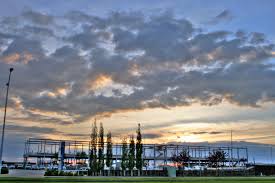Planning and Designing Industrial Parks for Efficiency and Productivity
Industrial parks are essential economic drivers because they create jobs, stimulate innovation, and strengthen local economies. Industrial parks design must be constructed and planned with efficiency and productivity in mind if they are to be truly effective. These sites can become vibrant ecosystems with proper planning and design, allowing business entities to work in an organized manner.
Let's look at some of the important factors and tactics for constructing and planning industrial parks that increase efficiency and productivity.
Strategic site location: The first stage in
designing an industrial park is to choose an ideal site. Access to
transportation networks such as highways, railways, and ports is critical for
efficient logistics and supply chain management. Furthermore, considering the
availability of a trained personnel as well as access to critical utilities
such as power, water, and telecommunications is critical for operational
efficiency. Sojitz Motherson Industrial Park in Chennai is built just
2.7 KM from National Highway NH4 connecting Chennai to Bengaluru making it easy
for businesses to ship their products and receive raw materials.
Zoning and infrastructure: Effective zoning
within an industrial park ensures compatibility and minimises disputes between
different types of enterprises. Separating sectors based on industry type, such
as manufacturing, logistics, or R&D, provides for simpler operations and
promotes collaboration among enterprises within the park. Furthermore, strong
infrastructure is critical for productivity. A well-designed industrial park
must have adequate road networks, ample parking spaces, effective waste
management systems, and dependable electricity and water supply.
Connectivity and technology: In today's
digital world, industrial parks necessitate connectivity and technology.
Businesses can use automation, IoT, and other digital technologies thanks to
high-speed internet connectivity, advanced telecommunications infrastructure,
and dependable data networks. Smart infrastructure, such as sensor-based
systems for resource monitoring and optimisation, boosts production and
operational efficiency.
Green spaces and amenities: Creating a
welcoming and appealing atmosphere within industrial parks is critical for
employee well-being and productivity. Green spaces, recreational areas, and
amenities such as cafes, fitness centres, and childcare facilities not only
increase employee satisfaction but also build a sense of community. Such benefits ofindustrial park can help to maintain a healthy
work-life balance and boost overall productivity.
Future expansion and flexibility: When
designing industrial parks, a forward-thinking strategy is required. Anticipating
future expansion and allowing for scalability ensures the park's ability to
accommodate changing needs and attract new firms. Providing adaptable premises
for various sectors and business sizes enhances long-term sustainability and
economic viability.
Opportunities for collaboration and networking:
Industrial parks should stimulate collaboration and networking among firms in
the ecosystem. Creating shared places, such as co-working spaces, innovation
hubs, and incubation centres, encourages knowledge exchange, creativity, and
synergistic collaboration. Furthermore, organising industry-specific events,
conferences, and workshops can promote networking and collaboration, hence
increasing productivity and establishing a culture of continuous learning.
Sojitz Motherson Industrial Park is a prime
example of industrial park development. Efficiency and productivity are
key to the design and operation of Sojitz Motherson Industrial Park. Sojitz
Motherson Industrial Park exemplifies how well-planned industrial parks can
improve the efficiency and productivity of firms that operate within them.




Comments
Post a Comment